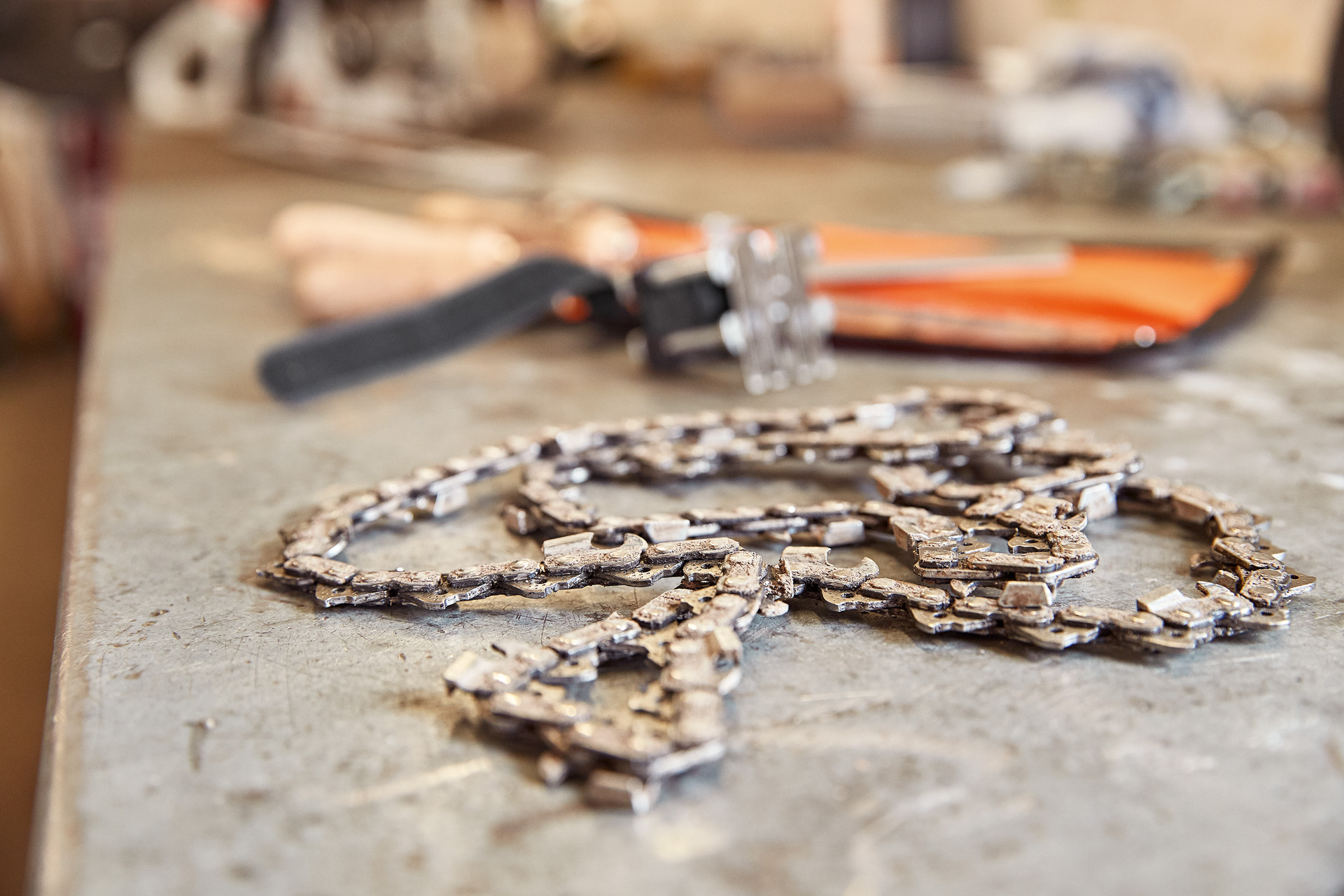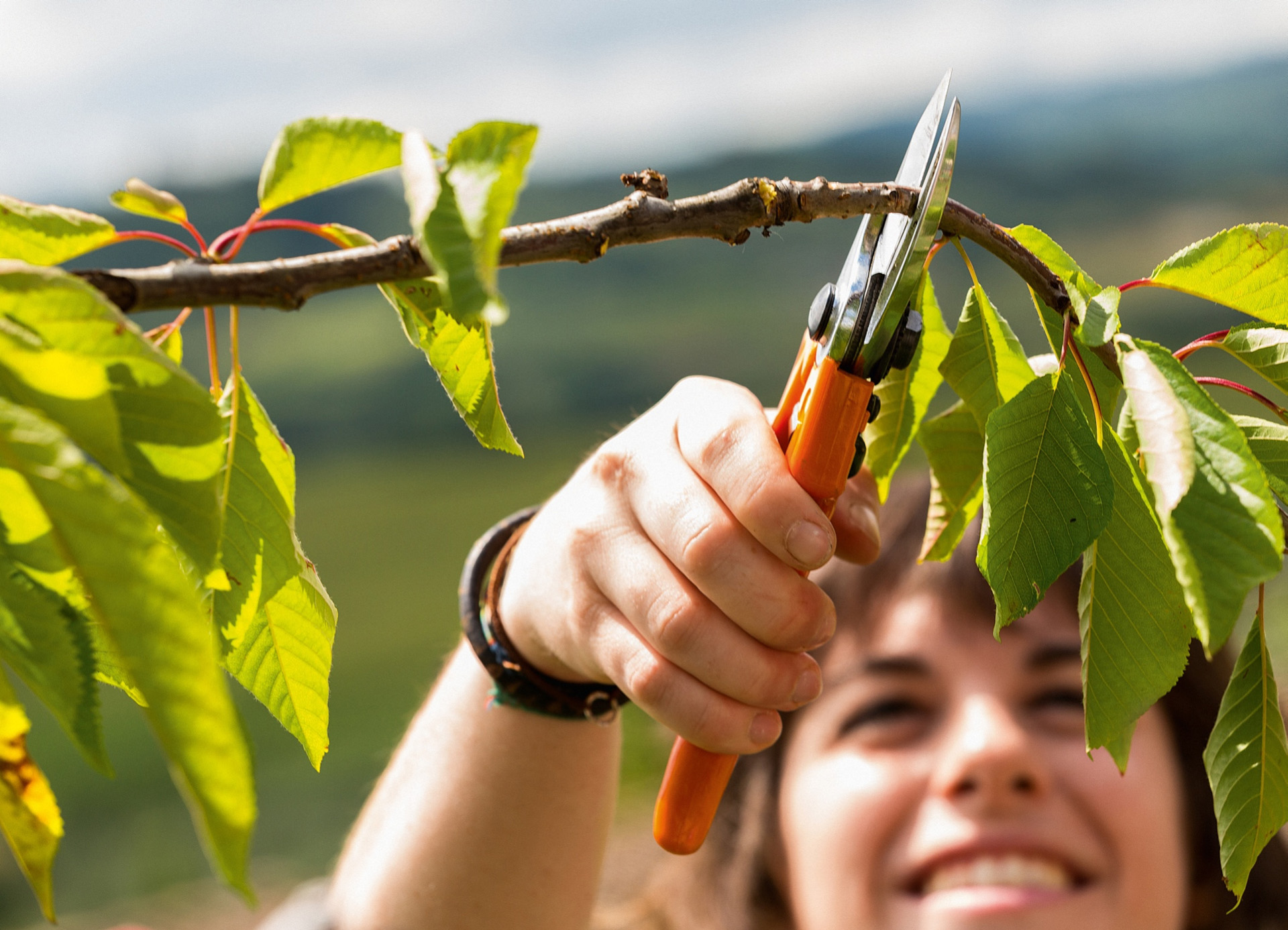Chainsaw care: how to sharpen a saw chain
All cutting attachments need regular maintenance to perform at their best. Learn how to sharpen your STIHL chainsaw so you get the best possible cutting performance.
01.10.2024


How can I tell if my chainsaw chain is blunt?
Even the best saw chains become blunt over time, and when they do your chainsaw becomes less effective and suffers increasing wear. If you notice any of the following while working with your chainsaw, you should sharpen or possibly even replace your saw chain.
Five signs that it’s time to sharpen your chainsaw chain
1.
When you use your chainsaw the cutting attachment doesn’t pull itself into the wood; instead you have to force it to cut by pushing down on the handles.
2.
When cross cutting, the saw chain produces fine sawdust rather than coarse chips.
3.
When you make a cut it produces smoke, even when the chain is lubricated correctly and chain tension is correct.
4.
The chainsaw does not cut straight and the cut pulls over to one side. This can indicate that you need to sharpen the blade teeth on one side, or that they are not of an even length.
5.
The chainsaw chatters and bounces when sawing, which makes it difficult to use with precision.

Video instructions: how to file your chainsaw chain using the STIHL 2-in-1 EasyFile
Our video instructions show you how to sharpen the saw chain and adjust the depth gauge on your STIHL chainsaw at the same time, using the 2-in-1 EasyFile.
What is the depth gauge setting?
The depth gauge setting is the distance between the leading edge of the tooth top plate and the upper edge of the depth gauge. The larger the distance, the more wood is planed away by each tooth. This setting is reduced when you sharpen the chainsaw teeth, as you make the whole tooth shorter and change its shape.
The 2-in-1 EasyFile maintains the depth gauge automatically by filing both the tooth and depth gauge at the same time!

Sharpening with a saw chain file
The tool you need to sharpen the teeth on a saw chain is a round file – you must make sure you use the right type and size of file for your chain, otherwise you may impair the cutting performance of your chainsaw.
The diameter of round file needed depends on the chain pitch of the saw chain you need to sharpen.
How to sharpen your chainsaw: choosing the right round file
Chains are assigned to specific chainsaw performance classes based on the chain pitch. On STIHL saw chains this is easily identifiable by means of a code on the depth gauge of each cutting tooth, which you can cross-refer with the STIHL saw chain file size chart provided below.

If the number displayed on the tooth is no longer legible you may need to measure it using a chain control gauge. Alternatively, you could calculate it yourself: use a calliper to measure the distance from the middle of a rivet to the middle of the next rivet but one. Halve the result to determine the distance in millimetres. Chain pitch is always listed in inches, therefore you will need to convert the measurement - one millimetre equals 0.039 inches, meaning you need to multiply the measurement in millimetres by 0.039 to get the equivalent in inches. Then use the STIHL saw chain file size chart to look up the file diameter that fits the measurement (in inches). Your nearest STIHL dealer will also be happy to assist with this.
| Code digit on the depth gauge | Chain pitch | Round file diameter |
|---|---|---|
| 1 | 1/4" | 4.0 mm |
| 2 | .325" | 4.8 mm |
| 3 | 3/8" | 5.2 mm |
| 4 | .404" | 5.5 mm |
| 6 | 3/8" Picco | 4.0 mm |
| 7 | 1/4" Picco | 3.2 mm |

Good to know
Saw chain files are different from workshop files and other files. They have a special surface structure, known as a file stroke, that makes them suitable for sharpening saw chains. You should never use other file types to sharpen your chainsaw.
How to sharpen a saw chain using a filing kit
Before you begin to sharpen your chainsaw, you must first be certain that you have a safe workstation: you need sufficient space and the right tools. We recommend you wear gloves made from robust material to help prevent accidental cuts, and the guide bar needs to be firmly clamped in a vice to prevent movement.
Next, clean the saw chain thoroughly and check it for damage. Before you begin, increase the chain tension to reduce the movement of the teeth during the filing process. Identify the most heavily worn-down tooth and mark it with a felt tip pen or similar. You will use this as a reference and sharpen all the teeth to the length of this one.
Check that no teeth have worn down to the wear marking: if they have, we recommend replacing the saw chain completely.
To successfully sharpen your chainsaw, you need to guide the file as you work. Hold the handle firmly with one hand and with the other hand guiding the end, move the file in forward strokes along the tooth face. First sharpen the reference tooth. Position the file in such a way that you can apply pressure, and work from the inside of the cutting face to the outside. Always hold the file horizontal, at a 90-degree angle to the face of guide bar. It should only make contact on the forward stroke – lift it clear when you move it back. Rotate the file occasionally to prevent it from wearing unevenly.
To sharpen STIHL saw chains use a sharpening angle of 30 degrees – a filing aid has markings that make it easy to be certain you are filing at the correct angle. The only exception is Rapid Hexa, which is sharpened at 25 degrees instead.
As you sharpen the tooth, keep the saw chain file at such a height that it protrudes above the top plate by a quarter of its diameter.
Following these instructions, work on the reference tooth until the tooth is sharp. In general we recommend a “little and often” approach to filing and sharpening as part of your chainsaw care. As well as keeping your chainsaw in great working condition, it is easier than having to do a lot of laborious filing in one go.

If you can see variations in the light reflections on the cutting edge, the tooth is not yet sharp: only when the surface is uniformly reflective can you be sure the tooth has been properly sharpened.
Once you have perfected the reference tooth, sharpen the rest of the teeth in that row to the same length. Then rotate the chainsaw 180 degrees and sharpen all the teeth in the other row. Make sure you file all of them to the same length as the reference tooth.

You may need to adjust the depth gauge after you sharpen the chainsaw teeth.
Note: When depth gauges are too low, the risk of chainsaw kickback is increased.
To check, use the appropriate filing gauge for the chain pitch and simply place it onto the tooth – if the depth gauge is higher than the filing gauge it needs to be filed down, with a flat saw chain file used in a horizontal position, until it is flush with the filing gauge. For saw chains with humped drive links, file the humps at the same time as the depth gauge.
Once the depth gauge height is correct, file the top of the depth gauge at an angle parallel to the service mark on the link – don’t remove any more height as you do this, and take care not to touch the newly sharpened blade tooth with the flat file.
Freehand sharpening is more susceptible to errors, so we recommend using a filing gauge; however, it is possible to adjust the depth gauge without one. You should work according to the service mark at all times. Important note: you must always use a flat file to adjust the depth gauge. Round files are not suitable here!

How to sharpen a chainsaw: tips and tricks
- Start by colouring in the tooth face of one tooth with a felt-tip pen. This helps you remove material evenly as you sharpen. After two to three file strokes, check the face: if the coloured pen has been uniformly removed, you’re filing correctly. If colour remains in places, check that you are using the correct saw chain file and that you are not moving the file too high or too low.
- Do not keep working with a saw chain until it is completely blunt. Instead, sharpen lightly but regularly to keep your chainsaw functioning well.
- Count the number of strokes you take with your file and apply the same number to each tooth. This way all the teeth end up the same length.
- If you find that the teeth are shorter in one row, you have applied greater filing pressure to one side. Even out the length by applying one or two file strokes on the longer teeth.
- Product tip: The 2-in-1 Easyfile enables you to sharpen your chainsaw teeth and restore the depth gauge to the correct height at the same time.
Operating instructions for STIHL chainsaws
You can download the instruction manual for your STIHL chainsaw here at your convenience.
Summary: how to sharpen your chainsaw
A blunt chainsaw is not only more difficult to use, but also less safe
Do a little preparation and ensure you have the right tools to sharpen your chainsaw
- Use a suitable round saw chain file to sharpen the teeth on your chainsaw
- We recommend reading the operating instructions for your chainsaw before you perform maintenance work on it or sharpen it








